Conservation, reconstruction and authentication of artworks are all domains in which photonics plays a significant role. This article describes some of the most established applications of photonics in cultural heritage.
Louis Bonnefous, Institut d'Optique Graduate School, Anke Lohmann, Knowledge Transfer Network and Carlos Lee, European Photonics Industry consortium (EPIC)
We can say without doubt that Vatican City is the city/state that has, on its territory, the most amazing concentration of artwork in the world. With its 0.44-square-kilometer (0.17-square-mile) area, Vatican City is blessed with vast cultural wealth. A recent visit to the Holy See as part of a special event organized by Quanta System was a great opportunity to inquire about and report on the photonics technologies employed in cultural heritage.
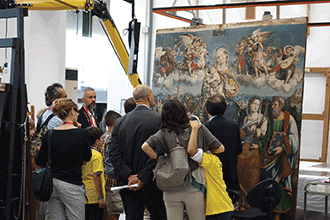
The exclusive visit of Quanta System to the restoration laboratories of the Vatican museum. Courtesy of Carlos Lee.
Structure analysis of paintings
Photonics experts are able to analyze very accurately every single layer of a painting. This is made possible by some different yet complementary techniques described below:
• IR reflectography: When the first pencil traces of the painter reveal their secrets.
How exciting would it be to discover the original pencil sketch of a genius artist, drawn centuries ago and hidden under the many coats of paint, or even discovering a painting under another one? Thanks to photonics, experts in IR reflectography are now able to know the first pencil traces of any painting. The method is based on the fact that paint pigments are more transparent at IR wavelengths than at visible wavelengths. It means that IR light will penetrate the outer layers of a painting, the varnish coating and every single paint layer, and will be absorbed only by the carbon-based layer of the painting, which is the one drawn with a traditional graphite pencil. Therefore, if the painting is imaged with an IR camera, the outer layers will appear transparent and the carbon-based one will absorb the light and will be available to the investigator. The first pencil traces of the artist no longer remain silent.
• Optical Coherence Tomography (OCT): When photonics provides very detailed images of artworks’ substructures.
OCT systems are fast-scanning IR Michelson interferometers. OCT allows in-depth scanning of a light diffusing material from which a 3D image can be created. The technique is very successfully deployed in medical eye scanning. The interior of the eye, especially the retina, is an example of a material that diffuses light, and with OCT we can get very detailed images of different cell layers that can show abnormalities such as retinal detachment. A recent new application of the OCT technique has been found in cultural heritage — museum conservators, like surgeons, are now very good friends with photonics experts, as they can provide full 3D images of a painting noninvasively. Some institutions, such as the British Museum and the National Gallery in London, have already adopted OCT to analyze their artworks.
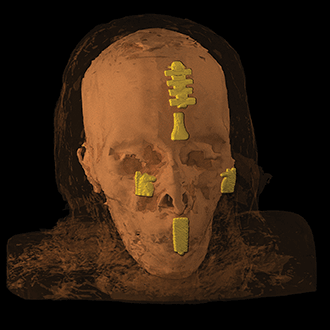
The Rhind Mummy was excavated from a tomb in Thebes, Egypt, and remains intact in its original wrapping. As this will never be opened, advanced visualization techniques will be necessary to look inside. Holoxica Ltd. in Edinburgh, Scotland, could make ananimated hologram from the CT data. Courtesy of Holoxica Ltd.
• X-ray spectroscopy: When photonics can be used to determine if a painting is real or a fake.
X-ray imaging enables discovery of what is hidden under the coatings and more precisely the chemical composition of artworks and most often paintings. The principle is simple: an intense x-ray is focused on a precise point of the painting. This causes the pigments to fluoresce and the florescence spectrum depends on the chemicals in the pigment. By measuring the spectrum, the experts can determine the exact chemical composition. This method is used to judge if a painting is authentic or fake, or to recreate the paint for restoration.
• 3D holography and scanning: When artworks take on an ultrarealistic, lively look.
The Nobel Prize in physics was awarded in 1971 to Hungarian Dennis Gabor for the development of holography. This imaging technique already has fantastic applications in cultural heritage. In artwork, holography is used to identify areas where paint may be peeling off, for example on church ceilings. 3D scanning is used to capture not just the color of the paint but also surface structure, which is a subtle yet important part of the viewer’s experience. This information is then digitally processed and can be used to create prints that are much closer to the original artwork. With advancements in the quality of digital holographic images, and thanks to 3D scanning, art conservators can access both color details and paint structures of priceless artworks, and can produce images that are much closer to the original than a standard 2D reproduction. 3D scanning and holography are tools widely used in art museums to
display fully detailed and enjoyable images of some artworks. And some holograms of masterpieces have, in turn, become masterpieces. Great detail can sometimes be found only with 3D images. Ultrarealistic color holography has reached a point where the hologram is indistinguishable from the original artifact by the untrained eye. This is thanks to advances in red, green and blue laser technology. The hologram only requires a simple LED light to display the 3D image. The holograms can be used in exhibitions where the original artifacts are on loan elsewhere. Examples include the Fabergé Egg collection in St. Petersburg, Russia, and religious icons at the Museum of Byzantine Culture in Thessaloniki, Greece.
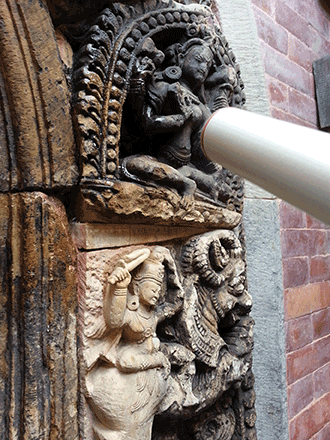
Restoration of Patan Royal Palace portals in Nepal. Courtesy of Quanta System.
Hyperspectral imaging
With standard color imaging, only three images — one each in blue, green and red — are taken of a picture. Reproducing the accurate color of an image from this information is difficult and capturing the chemical signature is impossible. A solution to this is hyperspectral imaging. Instead of three images, a whole stack of images is captured, each in different colors or wavelengths. This means that spectral information of the scene is provided pixel by pixel and is a unique signature of the color. The properties of hyperspectral imaging have thus facilitated processes of digital archiving and color reproduction. Moreover, the information obtained is objective, repeatable and does not change over time, which allows monitoring of artworks’ conservation status.
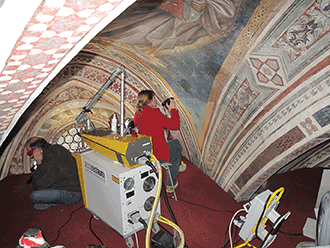
Restoration of the Cappella Maggiore chapel at the Basilica of Santa Croce in Florence, Italy. Courtesy of Quanta System.
Laser cleaning and restoration of artworks
Laser cleaning technology can effectively remove, within a restoration process, a wide range of contaminants such as oxidized or calcified deposits from almost any surface (painted surfaces, stone, bronze, iron, etc.). Thanks to the proper combination of selective absorption of the laser radiation with suitable short radiation/matter interaction, it becomes possible to “clean” artworks without any damage. Whenever the layer to be removed has an absorption coefficient much higher than the substrate, at a specific laser wavelength, the laser cleaning can be easily and safely performed within an intrinsically self-limiting process. For example, art restorers are using nanosecond-pulsed UV lasers to remove damaged varnish from paintings and nanosecond-pulsed IR lasers to ablate black encrustations from marble. Thin layers with similar absorption coefficients, such as paintings on wood or canvas, are actually challenging the restorers to properly match the “cleaning” by suitable selection of the laser wavelength at 1.5 to 2 µm with very small penetration (i.e., very high absorption in the first layers) with short and ultrashort pulse durations.
One of the most remarkable examples of restoration made possible by laser technologies can be found inside the well-known Pauline Chapel in Vatican City. Quanta System, a significant player in worldwide laser technology, donated one of its systems to the Holy See in 2008 to restore many of Michelangelo’s masterpieces. Quanta technologies were also used to clean artworks such as the Brandenburg Gate in Berlin, the St. Stephen’s Cathedral in Vienna and the Porta della Carta of the Doge’s Palace in Venice, Italy. Other examples of artwork that have been cleaned by laser technology include the Catacombs of St. Domitilla in Rome and the Parthenon Frieze in the British Museum in London.
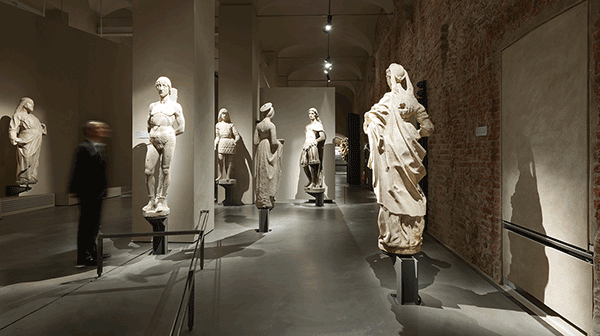
Austrian lighting manufacturer Zumtobel Group has set the course for visitors to experience an authentic and glare-free exploration of exhibits at the Museum of the Cathedral, located inside the Palazzo Reale in Milan. The color temperature can be selected directly on the spotlight, and replaceable optics can be individually adjusted; they provide the versatility and flexibility required by the exhibits’ different materials. Courtesy of Zumbotel.
Reconstruction of important monuments
Laser technologies also enable the reconstruction of important monuments using 3D mapping with lidar. When disasters like earthquakes or tsunamis occur, for example, lidar technology enables engineers and architects to assess the damage caused to the monument and understand how to repair it. In addition, by analyzing cause and effect, new systems and structures can be engineered around the monument to prevent future damages. For cultural heritage and ancient monument preservation, lidar technology is a precious tool to art conservators in particular when combined with multihit detection capabilities or mounted on drones. Lidar scans can be transferred to digital holograms for full 360-degree viewing of the monument by the public. Ancient monuments are also under threat from terrorist organizations or natural disasters, so their preservation by digital and optical techniques is crucial for the future.
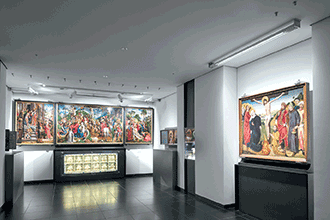
The Aachen Cathedral Treasury in Germany houses a unique collection of treasures from the long history of the iconic religious building where Roman-German kings were once crowned. It has been renovated with a discrete and energy-efficient LED lighting solution from Austrian lighting manufacturer Zumtobel. Courtesy of Zumbotel.
LED lighting
How can we ensure that artworks reflect their true charms and reveal their best secrets? The solution can be found in LED lighting. LED lighting systems offer many advantages — importantly, they contain no UV and IR radiation, which are known to damage artwork. Secondly, they are energy-efficient. Thirdly, they have great color rendition, an important measure when wanting to show the artwork in its best light. The Sistine Chapel in Vatican City already adopted LED lighting in 2014 to enhance Michelangelo’s extraordinary works on the chapel’s ceiling. Thousands of LEDs provide almost 10 times more brightness than the previous lighting technology and allow the viewer to see greater details of these important paintings. Moreover, the colors emitted by the LED have been tuned to the paint pigments of Michelangelo’s artworks, making them more vibrant. Of course, one could speculate whether Michelangelo intended that with his paintings.
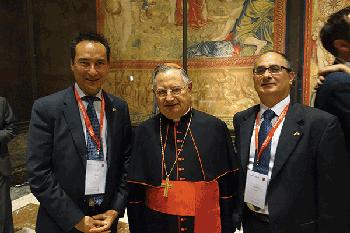
EPIC’s Carlos Lee, left, Cardinal Giuseppe Bertello and Antonio Raspa of Quanta System, which donated several laser systems for use in the cultural heritage projects. Courtesy of Carlos Lee.
Light is essential when viewing any artwork. It is used to create it and it influences what we see. Light-based technologies are now recognized as very promising means to provide solutions for global challenges in a wide and growing list of human activities. With regard to cultural heritage, photonics applications can be found almost everywhere, primarily in conservation and preservation, and also in the reconstruction and authentication of cultural artworks.
Meet the authors
Louis Bonnefous is a second-year engineering student at Institut d’Optique Graduate School in France. He recently completed an internship at European Photonics Industry Consortium (EPIC); email: [email protected]. Carlos Lee is Director General at EPIC. He has a bachelor’s degree in business administration and finance, and an MBA in leadership and change management from United Business Institute; email: [email protected]. Anke Lohmann is head of Photonics and Quantum Technologies at Knowledge Transfer Network (KTN) in London. She holds a PhD from Imperial College London in tunable laser technology and a Dipl.-Ing. degree in electrical engineering from Dresden University of Technology in Germany; email: [email protected].